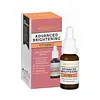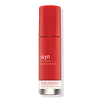What's inside
What's inside
 Key Ingredients
Key Ingredients

 Benefits
Benefits

 Concerns
Concerns

No concerns
 Ingredients Side-by-side
Ingredients Side-by-side

Water
Skin ConditioningAscorbyl Tetraisopalmitate
AntioxidantSqualane
EmollientCoco-Caprylate
EmollientDimethyl Isosorbide
SolventGlycerin
HumectantBetaine
HumectantSimmondsia Chinensis Seed Oil
EmollientPotassium Cetyl Phosphate
EmulsifyingTocopherol
AntioxidantHelianthus Annuus Seed Oil
EmollientRosa Canina Fruit Oil
EmollientXanthan Gum
EmulsifyingCetearyl Alcohol
EmollientSodium Phytate
Potassium Sorbate
PreservativeBenzyl Alcohol
PerfumingGlyceryl Laurate
EmollientCitric Acid
BufferingSodium Citrate
BufferingHydroxyethyl Acrylate/Sodium Acryloyldimethyl Taurate Copolymer
Emulsion StabilisingParfum
MaskingWater, Ascorbyl Tetraisopalmitate, Squalane, Coco-Caprylate, Dimethyl Isosorbide, Glycerin, Betaine, Simmondsia Chinensis Seed Oil, Potassium Cetyl Phosphate, Tocopherol, Helianthus Annuus Seed Oil, Rosa Canina Fruit Oil, Xanthan Gum, Cetearyl Alcohol, Sodium Phytate, Potassium Sorbate, Benzyl Alcohol, Glyceryl Laurate, Citric Acid, Sodium Citrate, Hydroxyethyl Acrylate/Sodium Acryloyldimethyl Taurate Copolymer, Parfum
Water
Skin ConditioningHydroxyethylcellulose
Emulsion StabilisingAngelica Archangelica Root Water
Skin ConditioningDimethyl Isosorbide
SolventAstaxanthin
Skin ConditioningErgothioneine
AntioxidantOxycoccus Palustris Seed Oil
AntioxidantRubus Chamaemorus Seed Oil
Skin ConditioningFullerenes
AntimicrobialPropanediol
SolventHaematococcus Pluvialis Extract
AntioxidantCamelina Sativa Seed Oil
Skin ConditioningThymus Vulgaris Flower/Leaf Extract
MaskingBuddleja Davidii Extract
Skin ConditioningGlycerin
HumectantZinc PCA
HumectantSimmondsia Chinensis Seed Oil
EmollientPanax Ginseng Root Extract
EmollientGlycosphingolipids
EmollientHippophae Rhamnoides Fruit Oil
Skin ProtectingPerfluorodecalin
Skin ConditioningTocopherol
AntioxidantTocopheryl Acetate
AntioxidantXanthan Gum
EmulsifyingEthylhexylglycerin
Skin ConditioningRosmarinus Officinalis Extract
AntimicrobialHelianthus Annuus Seed Oil
EmollientSodium Phytate
Butylene Glycol
HumectantPhenoxyethanol
PreservativeHydroxyacetophenone
AntioxidantPvp
Emulsion StabilisingSucrose Palmitate
EmollientCitric Acid
BufferingPotassium Sorbate
PreservativeSodium Benzoate
MaskingWater, Hydroxyethylcellulose, Angelica Archangelica Root Water, Dimethyl Isosorbide, Astaxanthin, Ergothioneine, Oxycoccus Palustris Seed Oil, Rubus Chamaemorus Seed Oil, Fullerenes, Propanediol, Haematococcus Pluvialis Extract, Camelina Sativa Seed Oil, Thymus Vulgaris Flower/Leaf Extract, Buddleja Davidii Extract, Glycerin, Zinc PCA, Simmondsia Chinensis Seed Oil, Panax Ginseng Root Extract, Glycosphingolipids, Hippophae Rhamnoides Fruit Oil, Perfluorodecalin, Tocopherol, Tocopheryl Acetate, Xanthan Gum, Ethylhexylglycerin, Rosmarinus Officinalis Extract, Helianthus Annuus Seed Oil, Sodium Phytate, Butylene Glycol, Phenoxyethanol, Hydroxyacetophenone, Pvp, Sucrose Palmitate, Citric Acid, Potassium Sorbate, Sodium Benzoate
 Reviews
Reviews

Ingredients Explained
These ingredients are found in both products.
Ingredients higher up in an ingredient list are typically present in a larger amount.
Citric Acid is an alpha hydroxy acid (AHA) naturally found in citrus fruits like oranges, lemons, and limes.
Like other AHAs, citric acid can exfoliate skin by breaking down the bonds that hold dead skin cells together. This helps reveal smoother and brighter skin underneath.
However, this exfoliating effect only happens at high concentrations (20%) which can be hard to find in cosmetic products.
Due to this, citric acid is usually included in small amounts as a pH adjuster. This helps keep products slightly more acidic and compatible with skin's natural pH.
In skincare formulas, citric acid can:
While it can provide some skin benefits, research shows lactic acid and glycolic acid are generally more effective and less irritating exfoliants.
Most citric acid used in skincare today is made by fermenting sugars (usually from molasses). This synthetic version is identical to the natural citrus form but easier to stabilize and use in formulations.
Read more about some other popular AHA's here:
Learn more about Citric AcidDimethyl Isosorbide is a low-irritation solvent that helps deliver actives into your skin. It is created from glucose.
Research shows how well this ingredient works depends on the active and formulation rather than the concentration alone. This means adding more Dimethyl Isosorbide does not guarantee better penetration of ingredients into the skin.
Glycerin is already naturally found in your skin. It helps moisturize and protect your skin.
A study from 2016 found glycerin to be more effective as a humectant than AHAs and hyaluronic acid.
As a humectant, it helps the skin stay hydrated by pulling moisture to your skin. The low molecular weight of glycerin allows it to pull moisture into the deeper layers of your skin.
Hydrated skin improves your skin barrier; Your skin barrier helps protect against irritants and bacteria.
Glycerin has also been found to have antimicrobial and antiviral properties. Due to these properties, glycerin is often used in wound and burn treatments.
In cosmetics, glycerin is usually derived from plants such as soybean or palm. However, it can also be sourced from animals, such as tallow or animal fat.
This ingredient is organic, colorless, odorless, and non-toxic.
Glycerin is the name for this ingredient in American English. British English uses Glycerol/Glycerine.
Learn more about GlycerinHelianthus Annuus Seed Oil is the oil derived from the seeds of a Sunflower. Sunflower seed oil is non-fragrant. It is an emollient, meaning it helps to soften the skin.
Sunflower seed oil contains many fatty acids. The fatty acids found in sunflower seeds include (from highest amount to least): linoleic acid, myristic acid, palmitic acid, stearic acid, arachidic acid, oleic acid, and linolenic acid.
These fatty acids help the skin create ceramides. Ceramides play a role in repairing the skin barrier.
Helianthus Annuus Seed Oil helps moisturize the skin. This in turn helps the skin look more rejuvenated and smoother.
Sunflowers are rich in vitamin E.
Historians believe Indigenous cultures of North America domesticated sunflowers before corn. Thus they relied on sunflower oil for a variety of uses. One such use is moisturizing skin and hair.
Sunflower seed oil may not be fungal acne safe. We recommend speaking with a professional if you have any concerns.
Learn more about Helianthus Annuus Seed OilPotassium Sorbate is a preservative used to prevent yeast and mold in products. It is commonly found in both cosmetic and food products.
This ingredient comes from potassium salt derived from sorbic acid. Sorbic acid is a natural antibiotic and effective against fungus.
Both potassium sorbate and sorbic acid can be found in baked goods, cheeses, dried meats, dried fruit, ice cream, pickles, wine, yogurt, and more.
You'll often find this ingredient used with other preservatives.
Learn more about Potassium SorbateThis oil comes from the seeds of the desert shrub called Jojoba. It is more commonly known as jojoba oil, a non-comedogenic oil.
Jojoba oil does not contain fragrance and has many fatty-acids, making it a great soothing ingredient.
It also contains Vitamin E, a great moisturizing ingredient. Vitamin E is also an antioxidant and protects your skin against oxidative damage.
This ingredient humectant properties, meaning it helps draw moisture from the air. This helps keep your skin hydrated.
While jojoba has antibacterial properties, it is only able to kill some strains of bacteria.
Studies also show it helps in wound healing. In fact, Indigenous cultures have used jojoba as a moisturizer and to help treat burns for centuries.
Fun fact: Jojoba oil similar to natural human skin sebum, so it has a great effect on dry skin. It is also promising with helping to regulate sebum production.
Due to its fatty acid content, Jojoba oil may not be fungal acne safe. We recommend speaking with a professional if you have any concerns.
Learn more about Simmondsia Chinensis Seed OilSodium Phytate is the synthetic salt form of phytic acid. Phytic acid is an antioxidant and can be found in plant seeds.
Sodium Phytate is a chelating agent. Chelating agents help prevent metals from binding to water. This helps stabilize the ingredients and the product.
Tocopherol (also known as Vitamin E) is a common antioxidant used to help protect the skin from free-radicals and strengthen the skin barrier. It's also fat soluble - this means our skin is great at absorbing it.
Vitamin E also helps keep your natural skin lipids healthy. Your lipid skin barrier naturally consists of lipids, ceramides, and fatty acids. Vitamin E offers extra protection for your skin’s lipid barrier, keeping your skin healthy and nourished.
Another benefit is a bit of UV protection. Vitamin E helps reduce the damage caused by UVB rays. (It should not replace your sunscreen). Combining it with Vitamin C can decrease sunburned cells and hyperpigmentation after UV exposure.
You might have noticed Vitamin E + C often paired together. This is because it is great at stabilizing Vitamin C. Using the two together helps increase the effectiveness of both ingredients.
There are often claims that Vitamin E can reduce/prevent scarring, but these claims haven't been confirmed by scientific research.
Learn more about TocopherolWater. It's the most common cosmetic ingredient of all. You'll usually see it at the top of ingredient lists, meaning that it makes up the largest part of the product.
So why is it so popular? Water most often acts as a solvent - this means that it helps dissolve other ingredients into the formulation.
You'll also recognize water as that liquid we all need to stay alive. If you see this, drink a glass of water. Stay hydrated!
Learn more about WaterXanthan gum is used as a stabilizer and thickener within cosmetic products. It helps give products a sticky, thick feeling - preventing them from being too runny.
On the technical side of things, xanthan gum is a polysaccharide - a combination consisting of multiple sugar molecules bonded together.
Xanthan gum is a pretty common and great ingredient. It is a natural, non-toxic, non-irritating ingredient that is also commonly used in food products.
Learn more about Xanthan Gum